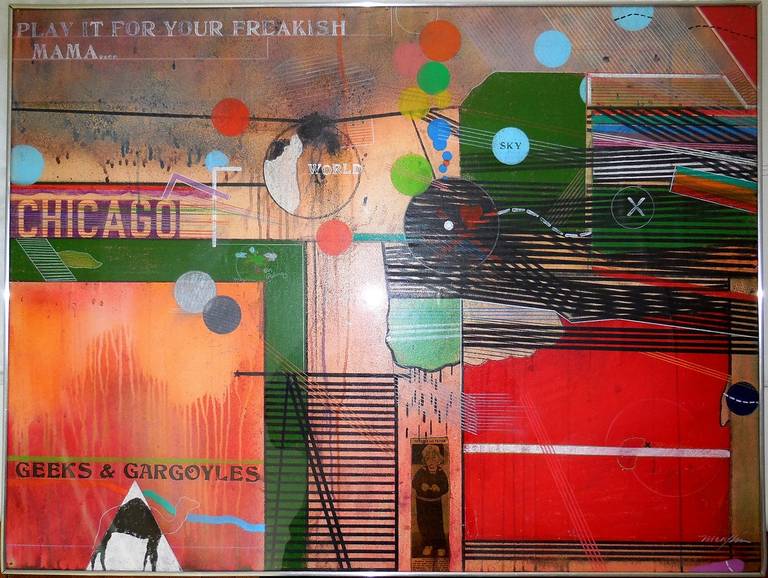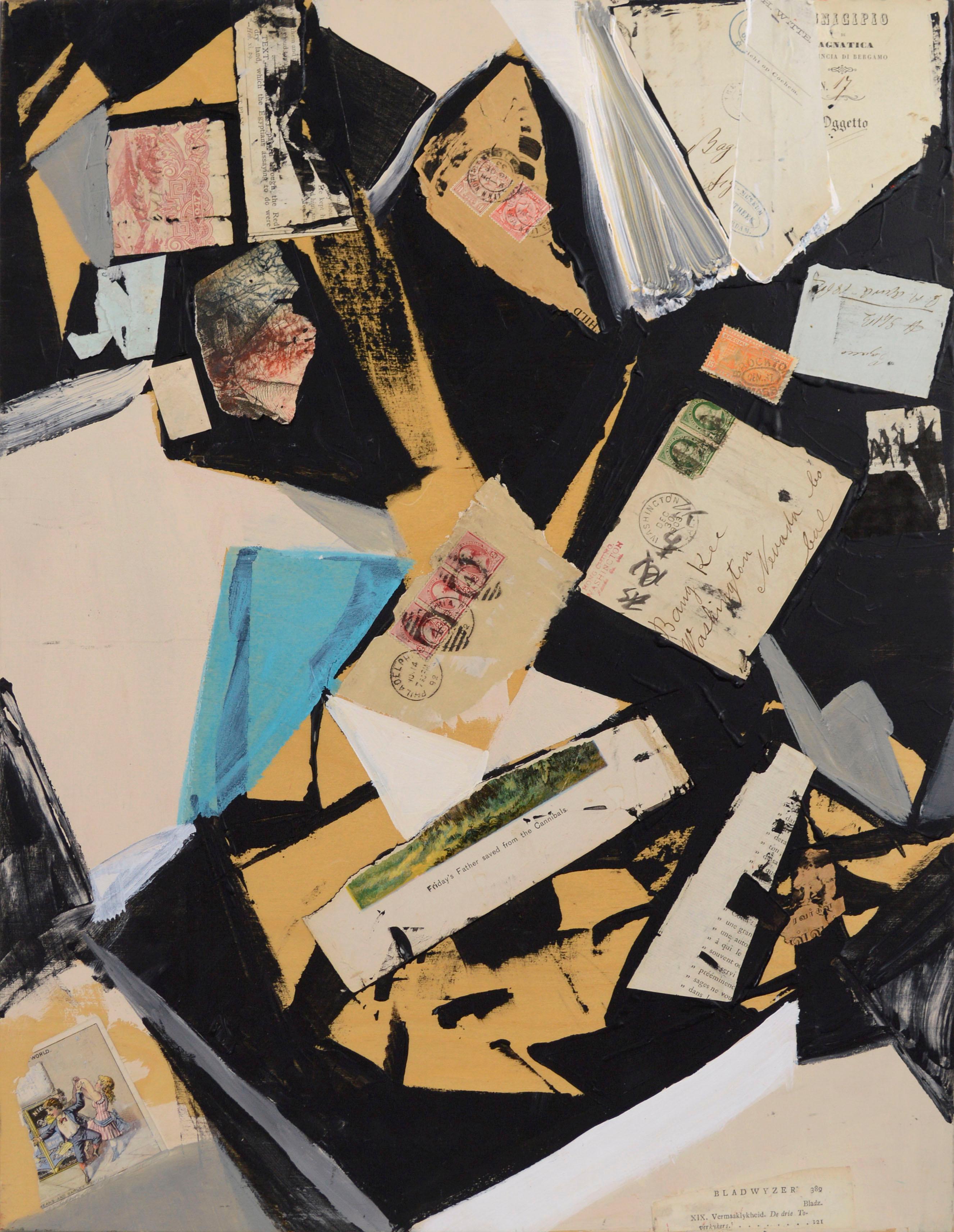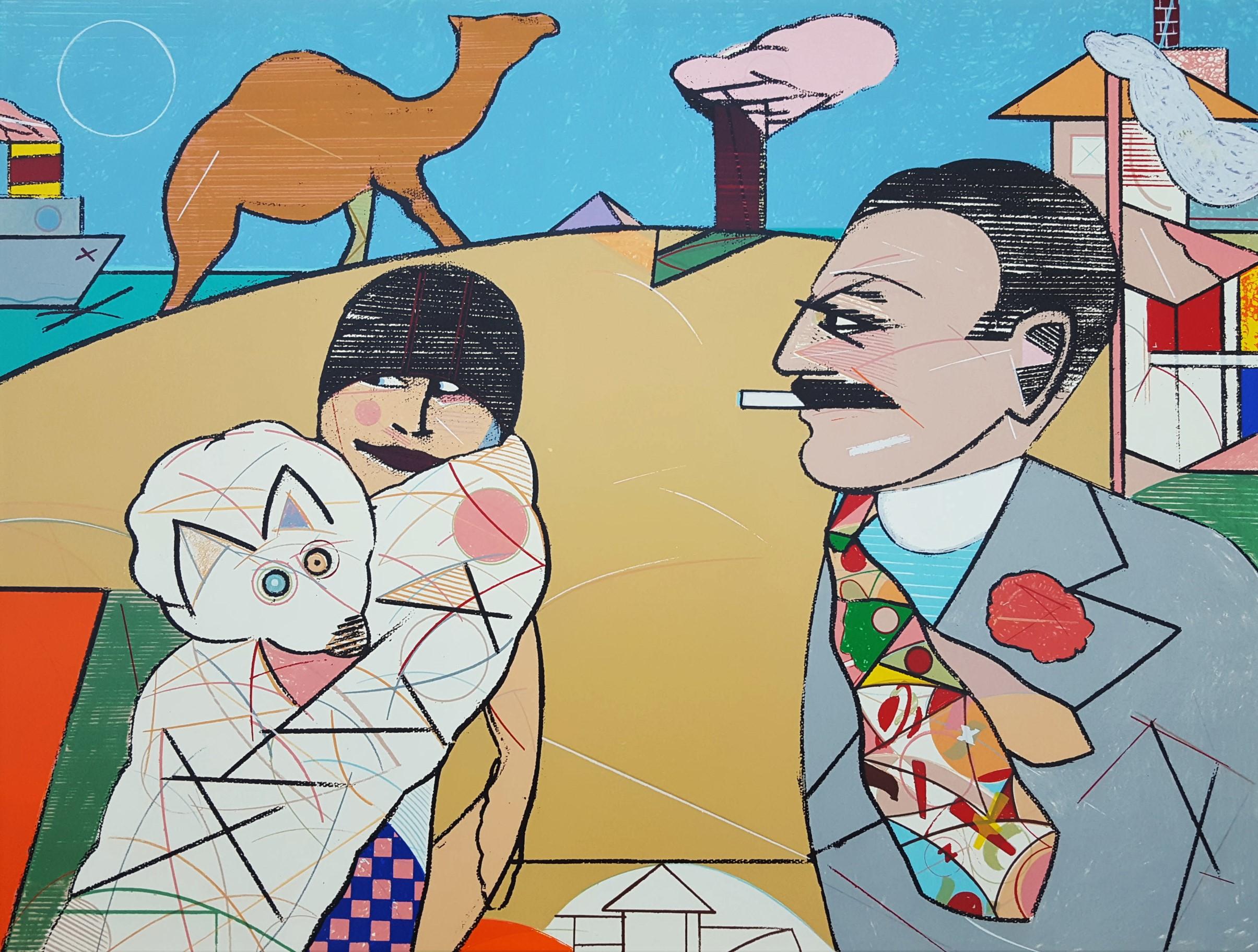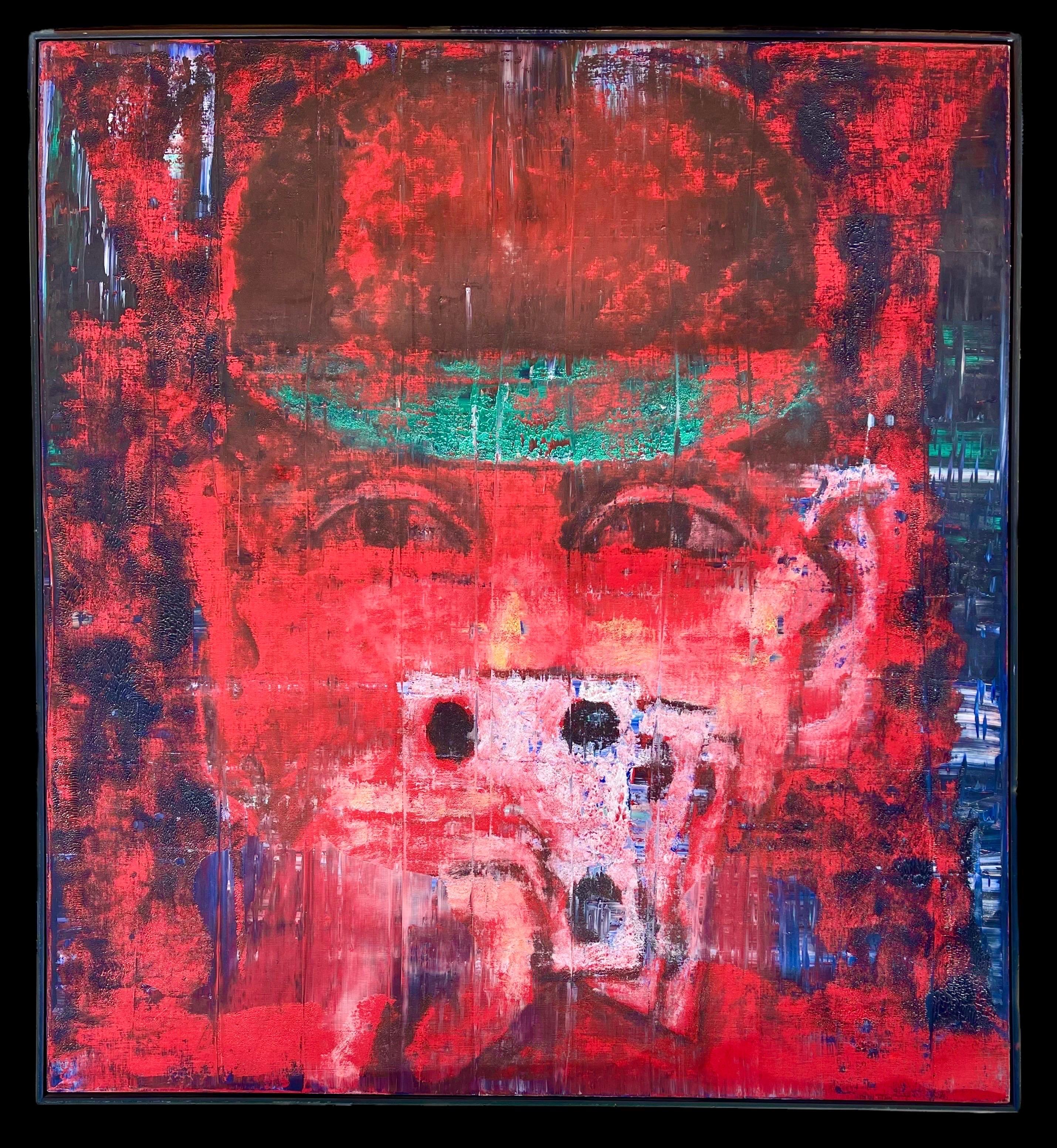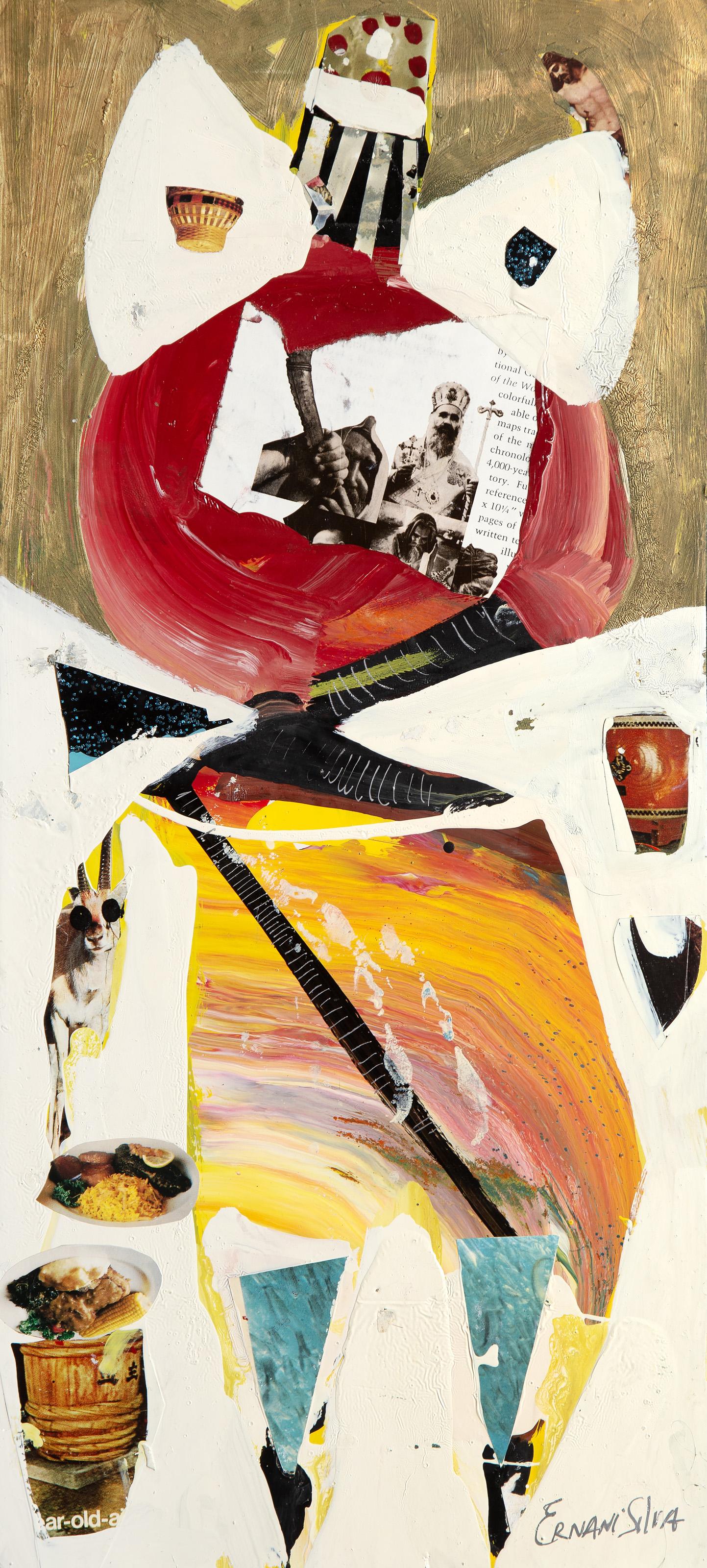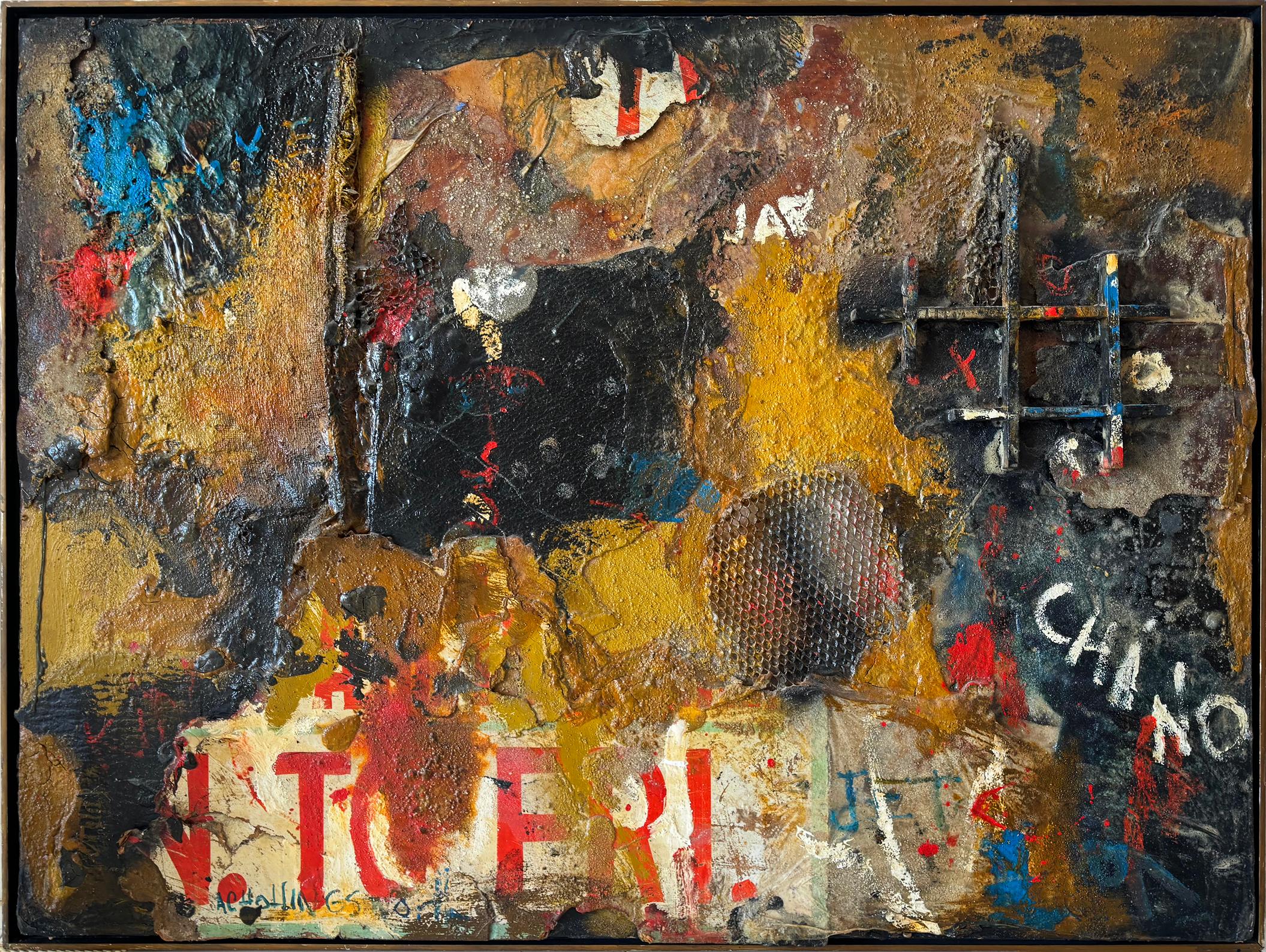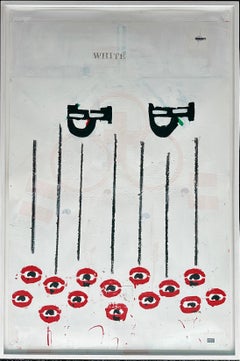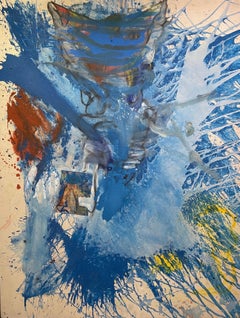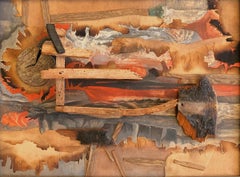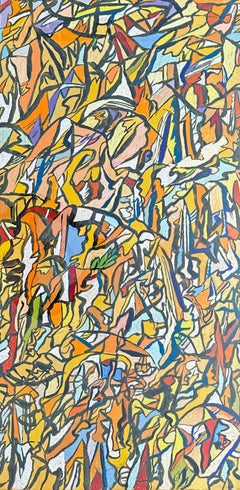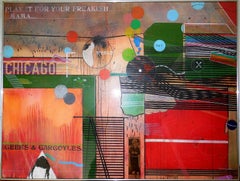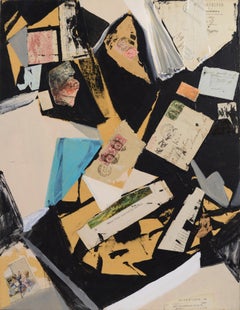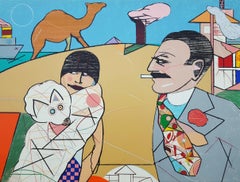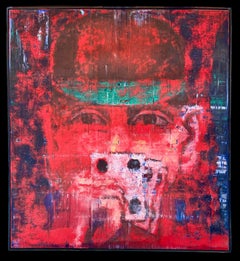Items Similar to Bulldog Drummond and the Great Coca-Cola Mystery by Richard Merkin
Want more images or videos?
Request additional images or videos from the seller
1 of 9
Richard MerkinBulldog Drummond and the Great Coca-Cola Mystery by Richard Merkin1965
1965
$14,500
£11,013.11
€12,667.09
CA$20,259.34
A$22,591.46
CHF 11,787.26
MX$277,205.72
NOK 150,033.04
SEK 142,153.05
DKK 94,539.16
Shipping
Retrieving quote...The 1stDibs Promise:
Authenticity Guarantee,
Money-Back Guarantee,
24-Hour Cancellation
About the Item
An iconic mixed media example of Richard Merkin's art.
Bulldog Drummond and the Great Coca-Cola Mystery (1965)
Mixed media on paper
51" x 33"
53" x 35" x 2" framed
Signed "Merkin" lower right. Dated and titled verso on Obelisk Gallery label.
Provenance: Obelisk Gallery, Boston, 1967 (label verso)
Ex. Coll. Finch College Museum of Art (label verso) – sold when the museum closed in 1983
Private Collection, Purchase, NY 1983-1994
About this artist: Richard Merkin’s vibrant painting career was characterized by a blend of popular culture, everyday life, humor, and personal insights. He attended Syracuse University before pursuing graduate studies in art at Michigan State University and the Rhode Island School of Design, where he proceeded to teach drawing and painting for forty-two years. Numerous materials on his work and teaching career were admitted to the RISD Archives.
Merkin was born in Brooklyn, New York in 1938, and established his art career there after returning to the city in 1967. He enjoyed regular showings at the Terry Dintenfass Gallery, and exhibited at the Obelisk Gallery, Boston, the DeCordova Museum, and as part of the Boston Arts Festival and Rhode Island Arts Festival. He was deeply inspired by the lively paintings of R. B. Kitaj, and frequently worked in a collage or assemblage style. Merkin specialized in capturing popular scenes from the 1920s, 1930s, and 1940s, and created portraits of cultural luminaries such as Joan Didion and Fran Lebowitz.
As a well-known dandy, Merkin worked with Manhattan tailor Vincent Nicolosi and associated with Manhattanites Alan Flusser, Thomas Wolfe, Eddie Hayes and Bobby Short. He authored the column “Merkin on Style” for Gentlemen’s Quarterly from 1988 to 1991, became a Contributing Editor for Vanity Fair in 1986. He regularly contributed illustrations to The New Yorker, Harper’s Bazaar, and The New York Times, and illustrated a book on African-American baseball leagues. He also maintained a claim to fame as part of the cover image from the Beatles’ Sergeant Pepper’s Lonely Hearts Club album, where he was pictured near Mae West, Carl Jung, and Bob Dylan.
Merkin eventually moved to Croton-on-Hudson, New York, where he died at the age of seventy. During his lifetime he was honored with the 1962-1963 Louis Comfort Tiffany Foundation Fellowship in Painting, and received the Richard and Hinda Rosenthal Foundation Award from the National Institute of Arts and Letters in 1975. He was also the recipient of prizes from the Providence Art Club Painting Annual in 1965, and the Silvermine Guild in 1963.
Written by Zenobia Grant Wingate
- Creator:Richard Merkin (1938 - 2009, American)
- Creation Year:1965
- Dimensions:Height: 51 in (129.54 cm)Width: 30 in (76.2 cm)
- Medium:
- Movement & Style:
- Period:
- Condition:Very good condition, appropriate for the age of this artwork.
- Gallery Location:Hudson, NY
- Reference Number:Seller: MeRi0011stDibs: LU2465213921002
Richard Merkin
Richard Merkin’s (1938 – September 5, 2009) work conjures up scenes that evoke the raucous spirit of the 1920’s, 30’s and 40’s. In his witty, often eccentric illustrations, Merkin depicts movie stars, jazz musicians, sports heroes and literary impresarios co-mingling with more personal references. In his highly stylized approach to the figure, Merkin privileges color relationships, balance and juxtaposition over strictly literal descriptions of his subjects. And humor; there’s always humor.
About the Seller
5.0
Vetted Professional Seller
Every seller passes strict standards for authenticity and reliability
Established in 1973
1stDibs seller since 2023
12 sales on 1stDibs
Typical response time: 2 hours
- ShippingRetrieving quote...Shipping from: Hudson, NY
- Return Policy
Authenticity Guarantee
In the unlikely event there’s an issue with an item’s authenticity, contact us within 1 year for a full refund. DetailsMoney-Back Guarantee
If your item is not as described, is damaged in transit, or does not arrive, contact us within 7 days for a full refund. Details24-Hour Cancellation
You have a 24-hour grace period in which to reconsider your purchase, with no questions asked.Vetted Professional Sellers
Our world-class sellers must adhere to strict standards for service and quality, maintaining the integrity of our listings.Price-Match Guarantee
If you find that a seller listed the same item for a lower price elsewhere, we’ll match it.Trusted Global Delivery
Our best-in-class carrier network provides specialized shipping options worldwide, including custom delivery.More From This Seller
View AllO.P. 88 collage on paper by Glenn Goldberg
By Glenn Goldberg
Located in Hudson, NY
O.P. 88 (1988)
Pencil, ink, enamel and collage on paper
46" x 30"
48 ½" x 32 ½" x 2" framed
Stamped "GG88" lower right by artist with his signature stamp.
Provenance: M. Knoedler &...
Category
1980s Abstract Mixed Media
Materials
Enamel
P.F.P. abstract oil collage by Bill Saylor
Located in Hudson, NY
P.F.P. (2011)
Oil on canvas with collage
Titled, signed and dated "P.F.P. / Bill Saylor / 2011" verso on canvas.
Exhibited 2017 in "Animal Farm" a group exhibition at The Brant Foun...
Category
2010s Abstract Abstract Paintings
Materials
Canvas, Mixed Media, Oil
Pyromaniac's Pyre mixed media work by Mary Spencer Nay
Located in Hudson, NY
Signed and dated "Mary Spencer Nay '74" lower left. Titled "Pyromaniac's Pyre" verso.
Exhibited:
1976-1977 "Mary Spencer Nay: Recent and Retrospective Works". J.B. Speed Art Museum...
Category
1970s Modern Abstract Paintings
Materials
Fabric, Canvas, Rubber, Wood, Oil
Untitled-006 abstract painting by Fred Martin
By Fred Martin
Located in Hudson, NY
Exhibited:
2003 Oakland Museum of California "Fred Martin Retrospective"
A native Californian, Fred Martin was born in San Francisco in 1927, and received both his BA (1949) and MA (1954) from University of California, Berkley. At the San Francisco Art Institute Martin studied with Clyfford Still, Mark Rothko and David Park...
Category
1970s American Modern Abstract Paintings
Materials
Masonite, Pastel, Acrylic
Mahler's Castle II by Budd Hopkins
Located in Hudson, NY
Budd Hopkin's Mahler's Castle paintings exemplified a shift away from his holistic single image paintings of 1971 and 1972 to a new hieraticism. Both Mondrian and Newman, for instan...
Category
1970s Abstract Expressionist Paintings
Materials
Canvas, Acrylic
Spring Landscape acrylic and pastel painting by Fred Martin
By Fred Martin
Located in Hudson, NY
Exhibited:
1973 San Francisco Museum of Art
2003 Oakland Museum of California "Fred Martin Retrospective"
A native Californian, Fred Martin was born...
Category
1970s American Modern Abstract Paintings
Materials
Masonite, Pastel, Acrylic
You May Also Like
Large Richard Merkin Painting Geeks & Gargoyles New Yorker Magazine Cover Artist
By Richard Merkin
Located in Surfside, FL
#9 Geeks and Gargoyles (for Nelson Algren)
Mixed Media and Collage
Provenance:
Obelisk Gallery, Boston, 1967 (label verso)
the word Chicago is featured prominently in this piece.
Sometimes described as Rhode Island’s most famous New York artist, Richard Merkin has led a dual life for nearly 40 years - teaching at RISD while enjoying a celebrated painting career based in New York City. He has exhibited in countless gallery and museum shows in the US and abroad and is represented in the permanent collections of the Smithsonian Institution, The Museum of Modern Art, the Whitney Museum, the RISD museum and many others. In addition to contributing drawings and paintings to The New Yorker (along with, Art Spiegelman, Saul Steinberg, Harper’s, The New York Times Sunday Magazine and several books on Erotica and Baseball, he is a contributing editor for Vanity Fair and a former style columnist for GQ. Merkin’s honors include a Tiffany Foundation Fellowship and the Rosenthal Foundation Award from the American Academy of Arts and Letters.
Museums and Selected Collections :
The American Federation of Arts, New York, NY
Brooklyn Museum, Brooklyn, NY
Chrysler Museum of Art, Norfolk, VA
First city Bank, Chicago, Ill
Fisk University Art Gallery, Nashville, TN
Hallmark Collections, Kansas City, MO
Massachusetts Institute of Technology, Cambridge, MA
Maimi-Dade Junior College, Miami, FL
Michigan State University, East Lansing, MI
Minnesota Museum of Art, Minneapolis, MN
Museum of Modern Art, New York, NY
Museum of Art, Rhode Island School of Design, RI
McClung Museum, University of Tennessee, Knoxville, TN
Pennsylvania Acadamy of the Arts, Philadelphia PA
Prudential Insurance Company, Boston, Ma
Prudential Insurance Company, Newark, NJ
Rose Art Museum, Brandeis University, Waltham, MA
Sara Robey Foundation, New York, NY
Smithsonian Institution, Washington, DC
State University of Brockport, Brockport, NY
Whitney Museum of American Art, New York, NY
Selected Publications :
1986-Present Contributing Editor, Vanity Fair ..1988-Present, New Yorker... 1988-Present, style column, GQ...1997, Text and Illustration for The Tijuana Bibles, published by Simon & Shuster, 1995, Illustrated book, Leagues Apart: the Men and Times of the Negro Baseball Leagues published by Morrow.
1967 Cover of the Beatles “Sgt. Peppers Lonely Hearts Club Band” Album (Mr. Merkin appears in the back row, right of center)
RISD: MFA in Painting, 1963; Professor, Department of Painting
special skill: Merging his role as flaneur (connoisseur of city life) with his role as painter and social historian, Merkin retrieves lost cultural artifacts – a Turkish cigarette, a gangster, a bowler and generally “things most people don’t know about” – and reconstitutes their Jazz Age virtues on canvas in cubist, comic-laced landscapes of tropical color. (ala Robert Crumb and Ben Katchor)
breaking in: Perpetually on the fly from his middle-class Brooklyn background, Merkin found the perfect escape in the mid ‘60s in George Frazier, a dapper Boston columnist who inspired the emerging New York painter’s overnight reinvention of himself. The elements of structure, stability and surprise he admired in this well-dressed dandy – a cool linen suit, a splash of suspender, a polka dot scarf and pearl-handled walking stick – soon surfaced in paintings peopled by impeccable underdogs of café society along with his personal pop heroes: William Burroughs, Bobby Short...
Category
1960s Abstract Paintings
Materials
Mixed Media
"Saved from the Cannibals" Contemporary Abstract Painting w Found Object Collage
By Michael Pauker
Located in Soquel, CA
A unique contemporary abstract expressionist painting with collaged found object elements, including a torn page from Robinson Crusoe, vintage stamps, and old letters by Bay Area art...
Category
2010s Contemporary Abstract Paintings
Materials
Wood, Mixed Media, Oil, Magazine Paper, Found Objects
Oedipus and Luxor /// Contemporary Richard Merkin Figurative Funny Screenprint
By Richard Merkin
Located in Saint Augustine, FL
Artist: Richard Merkin (American, 1938-2009)
Title: "Oedipus and Luxor"
*Signed by Merkin in pencil lower right
Circa: 1980
Medium: Original Screenprint on white Arches 88 paper
Limi...
Category
1980s Contemporary Figurative Prints
Materials
Screen
Large Modernist Oil Painting Card Poker Player Aaron Fink Pop Art Americana
By Aaron Fink
Located in Surfside, FL
Aaron Fink (American, b. 1955)
Hand signed and dated 1986, verso.
The large canvas size measures approx: 72" x 66". This painting is part of the artist's "Images of Gambling" series, amongst his best figural work.
Aaron Fink was born in Boston in 1955. He received his MFA from Yale University and his BFA from the Maryland Institute College of Art. His work has been exhibited widely throughout the U.S., Europe and Japan and Australia, and is included in the collections of the Museum of Modern Art, NY, the Art Institute of Chicago, the Museum of Fine Arts, Boston and the Walker Art Center, Minneapolis, among many others. He lives and works in the Boston area. He has been the subject of solo exhibitions at the Massachusetts Institute of Technology, the Muskegon Museum of Art, Michigan, the Rockford Art Museum, Illinois, and Colorado State University, Fort Collins. Figurative abstract expressionist art.
In 2002 a monograph on Fink’s work, Out of the Ordinary, was published, with text by Eleanor Heartney. In 1983 Fink met the collector John Powers, who remained a strong supporter of his work until his death in 1999. Fink’s work is represented in the collections of the Art Institute of Chicago, the Hara Museum, Tokyo, the Metropolitan Museum of Art, New York, the Museum of Modern Art, New York and the National Gallery of Art, Washington, DC, among many others. Fink currently divides his time between Boston and Rockport, Massachusetts.
He was included in the show The Expressive Voice: Selections from the Permanent Collection at the Danforth Museum of Art. An exhibition of Boston Expressionism, a school that embraced a distinctive blend of visionary painting, dark humor, religious mysticism, and social commentary. Historical roots of this movement can be traced to European Symbolism and German Expressionism, but artists living and working in the Boston area from the 1930’s through the 1950’s, were particularly inspired by Chaim Soutine and Max Beckmann. Artists included; Aaron Fink,
Bernard Chaet, David Aronson, Ernst Ludwig Kirchner, Hyman Bloom, Jack Levine, Jackson Pollock, Jason Berger, Karl Zerbe, Lawrence Kupferman, Michael Mazur, Sigmund Abeles and Willem de Kooning.
He was included in the show 40 Years of Printmaking: From the Center Street Studio Archives, along other great figural artists Gabor Peterdi, John Walker, Lester Johnson and Nell Blaine.
S E L E C T E D C O L L E C T I O N S
Art Institute of Chicago
Bank of America
Boston Public Library
Bouwfonds Nederlandse Gemeenten, The Netherlands
Brooklyn Museum of Art
Castelli Collection, New York
Chase Manhattan Bank
Chemical Bank
Choate Rosemary Hall, Wallingford, CT
Citizens Bank, Boston
Coopers & Lybrand
Danforth Museum, Framingham, MA
Danish House of Parliament
Davis Museum, Wellesley College, Wellesley, MA
DeCordova Museum and Sculpture Park Lincoln, MA
Farnsworth Museum, Maine
Fidelity Investments, Boston
Fogg Museum of Art, Harvard University, Cambridge, MA
Fuller Museum of Art, Brockton, MA
G.E. Corporation
Goldman Sachs & Company
IBM, New York
Indianapolis Museum of Art
Library of Congress
Massachusetts Institute of Technology, Cambridge, MA
Metropolitan Museum of Art, New York
Museum of Contemporary Art, Chicago
Museum of Fine Arts, Boston
Museum of Modern Art, New York
National Gallery of Art, Washington, DC
New York Public Library
Philadelphia Museum of Art
Portland Museum of Art, Portland, Maine
United States Department of State
University of Massachusetts, Amherst
Awards
Residency, Anderson Ranch, Snowmass, CO, 1998, 1996
National Endowment for the Arts, 1987, 1982
Artist Fellowship, Massachusetts Council on the Arts and Humanities, 1984
American Academy in Rome, Prix de Rome – Alternate in Painting, 1979
Yale University, Ford Foundation Special Project Grant, Fall 1979
Skowhegan Scholarship Award, conferred by the Maryland Institute College of Art, Spring 1976
SELECTED GROUP EXHIBITIONS
Contemporary Responses to Modernism: A New England Perspective, University of Southern Maine
Color and Line: Expressive Tradition in Boston, Endicott College, Beverly, MA,
Beautiful Decay, Danforth Art Museum, Framingham, MA
MICA Then and Now, Ethan Cohen Gallery, Beacon, NY
Bon Appetit, Concord Art Association
Celebrating Ten Years, Galerie D’Avignon, Montreal, Canada
New England Impressions: Exploring the Woodcut, Concord Art, Concord, MA
Go Figure: The Figure in Contemporary Art – A Response to Art History,
Painting in Boston: 1950-2000, DeCordova Museum and Sculpture Park, Lincoln, MA
Working Sources: The Painter and the Photographic Image, Alpha Gallery, Boston, MA
The Unique Print: Six Innovative Approaches to the Monotype, Starr Gallery, Newton, MA
Selections from Atelier Mourlot, Hankyu Department Store, Tokyo, Japan
Yale Collects Yale, Yale University Art Gallery, New Haven, CT, 1993
70’s and 80’s: Printmaking Now, Museum of Fine Arts, Boston, MA, 1986-1987
Skowhegan Alumni, Leo Castelli Gallery, New York, and Portland Museum of Art, Portland, Maine,
Public and Private: American Prints Today, Brooklyn Museum, Brooklyn, NY
Contemporary Miami Collectors, Metropolitan Museum, Coral Gables, FL, 1984
The American Artist as Printmaker, Brooklyn Museum, Brooklyn, NY, 1983-84
Jon Abbott, Aaron Fink, Tom Lieber, Chris Wool...
Category
1980s Pop Art Figurative Paintings
Materials
Canvas, Oil
Emperor, Folk Art Acrylic Painting by Ernani Silva
Located in Long Island City, NY
Ernani Silva, Brazilian - Emperor, Medium: Acrylic, Collage and Enamel on board, signed in marker, Size: 22 x 9.75 in. (55.88 x 24.77 cm)
Category
1990s Folk Art Figurative Paintings
Materials
Enamel
Untitled: Street Art - Graffiti Art Before Basquiat - African American
Located in Miami, FL
Sometimes, the most celebrated artists are not the most original. Such is the case with Jean-Michel Basquiat, known for bringing into mainstream abstract yet representational street ...
Category
1970s Street Art Mixed Media
Materials
Metal
